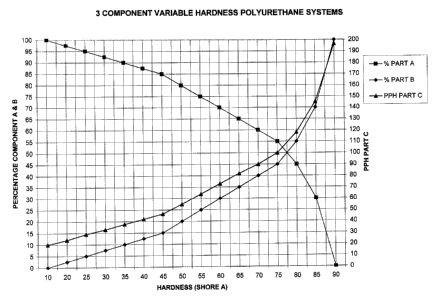Note : Les descriptions sont présentées dans la langue officielle dans laquelle elles ont été soumises.
CA 02480364 2004-09-02
MULTIPLE-COMPONENT VARIABLE HARDNESS
POLYURETHANE SYSTEM
Field of the Invention
This invention relates to thermosetting compounds. In particular, this
invention relates to a multiple-component thermosetting composition that uses
the
same basic components but the hardness of which can be varied over a wide
range
according to the proportion of the components used.
Background of the Invention
Thermosetting compounds are used in a variety applications. One popular
1o thermosetting compound, polyurethane, is used for example on rollers for
printers,
photocopiers and the like, in which a polyurethane coating is applied over a
steel
mandrell. Polyurethane is also popularly used to fabricate components for
manufacturing machinery, and in myriad other applications.
In many cases, manufacturers require thermosetting compounds having a wide
range of different hardnesses. This requires that many of different compounds
be
maintained in inventory, which can be an organizational problem and can be
quite
confusing to workers who have to locate the compound of the desired hardness
for a
particular application. The application of thermosetting compounds of
different
hardnesses also often requires that manufacturing equipment be changed or
adjusted
2o to accommodate the different properties of a thermosetting compound having
a
different hardness.
It would accordingly be advantageous to provide a system and method which
can create a thermosetting composition of a desired hardness within a wide
range of
hardnesses using a small number of components.
Summary of the Invention
The present invention provides a multi-component variable hardness
polyurethane system. According to the invention a thermosetting composition,
in
-1-
CA 02480364 2004-09-02
particular polyurethane, can be created having any desired hardness between 10
and
90 Shore A, by mixing the same curative components in different proportions ,
according to the hardness desired, along with a stoichiometrically determined
amount
of isocyanate as a hardener.
In the preferred embodiment the composition of the invention can be created
from three components: two curative components and an isocyanate. However,
additional components may be used to create a composition within the scope of
the
invention.
Brief Description of the Drawings
1o In drawings which illustrate by way of example only a preferred embodiment
of the invention,
Figure 1 is a graph showing percentages of components for the production of a
polyurethane of a defined hardness.
Figure 2 is a chart showing mix ratios for the components in the preferred
15 embodiment of the invention to create a composition having a hardness in a
range
from 10 Shore A to 90 Shore A.
Detailed Description of the Invention
In the preferred embodiment, the invention comprises a polyurethane
compound having specific. percentages of first and second curative components,
and
2o an isocyanate or hardening agent, for example methylene Biphenyl
isocyanate, added
in a stoichiometrically determined amount. The preferred components are
described
herein by way of example for the preferred embodiment, however the invention
is not
intended to be limited to the specific components so described.
The first curative component is selected to have a very low hardness when
25 mixed alone with the isocyanate, for example a composition containing
glycol polyol,
non reactive plasticizes, urethane catalyst, and a surfactant, in suitable
proportions.
The second curative component is selected to have a very high hardness when
mixed
-2-
CA 02480364 2004-09-02
alone with the isocyanate, for example a composition containing glycol polyol,
liquid
aromatic diamine, urethane catalyst, and a surfactant, in suitable
proportions. The first
and second components must be miscible, although, not necessarily upon first
mixing.
As can be seen from Figures 1 and 2, the relative percentages of the two
curative components are selected to create a polyurethane compound having a
desired
hardness. The amount of isocyanate added as a hardener is determined
stoichiometrically, based on the molecular weights and proportions of the
curative
components. A harder polyurethane requires a tighter crosslink chemistry, and
therefore smaller molecules, so as the hardness of the polyurethane compound
increases more isocyanate is required in the composition to maintain the
stoichiometric relation between the hardener and the curative components. The
percentage of each curative component can be selected from a chart generated
by
experimentation, for example as illustrated in Figure 2 in the case of the
specific
components used in the preferred embodiment of the invention.
Moreover, in the system and method of the invention the relationship between
the proportions of the twa curative components and the hardness of the
resulting
composition is relatively linear, so interpolation between incremental mixture
ratios
will achieve roughly the desired intermediate hardness. For example, to create
a
polyurethane compound having a hardness of 67.5 Shore A, and intermediate
amount
of curative components and isocyanate between the percentages shown in columns
11
and 12 of Figure 2 would be mixed to yield a compound having a hardness very
close
to the desired result. With some experimentation a precise hardness can be
achieved.
Various embodiments of the present invention having been thus described in
detail by way of example, it will be apparent to those skilled in the art that
variations
and modifications may be made without departing from the invention: The
invention
includes all such variations and modifications as fall within the scope of the
appended
claims.
-3-
